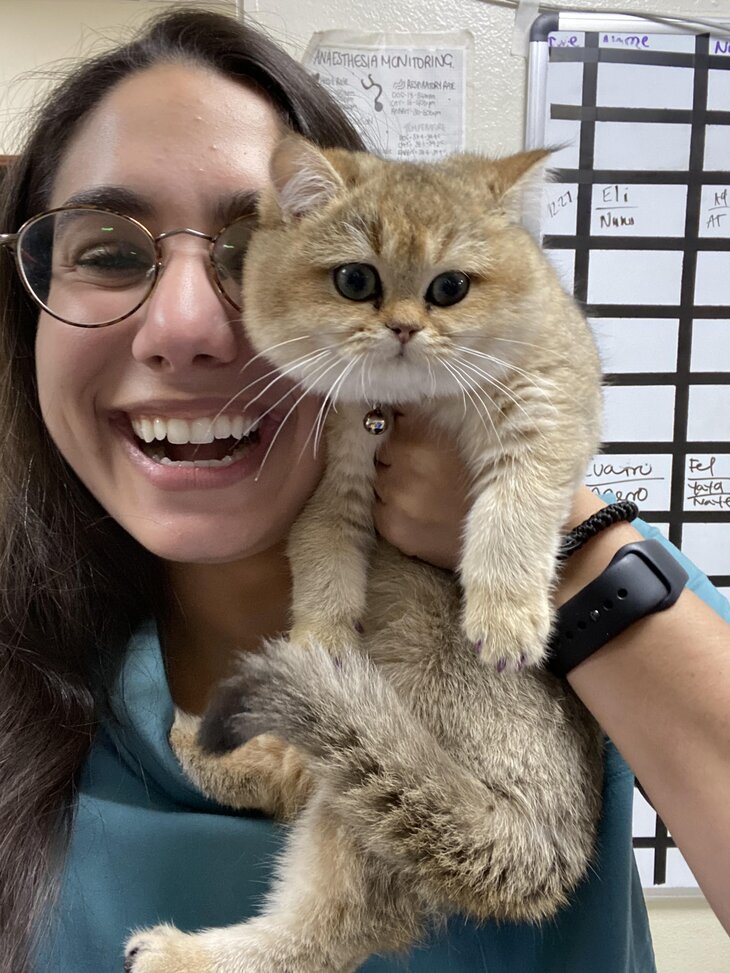How to Prevent Compassion Fatigue in Veterinary Medicine
For veterinary professionals, the capacity to form compassionate connections with their patients and clients is one of their greatest strengths, but it can also be a great vulnerability.
Compassion fatigue, also known as secondary traumatic stress or vicarious trauma, is the combination of physical, emotional, and psychological depletion that many veterinary caregivers experience after continuous exposure to animals’ pain and suffering.
While all care providers are susceptible to compassion fatigue, veterinarians are especially vulnerable due to how often they witness illness, trauma, and death in their patients. The condition is so prevalent that about 74% of veterinary professionals report having mild to moderate symptoms of compassion fatigue, while more than 25% are at risk for it. 1
So, is there a way to prevent compassion fatigue from occurring in your veterinary practice?
Table of Contents:

The Problem of Compassion Fatigue in Veterinary Medicine
Due to the fact that they are exposed to trauma on a daily basis (animal cruelty, death, and pet owners in financial difficulty, etc.), veterinary professionals are extremely vulnerable to developing compassion fatigue.
They also frequently face ethical dilemmas that cause a significant amount of moral distress, which is a major factor in compassion fatigue. Finances, end-of-life care, euthanasia, and inadequate health and welfare standards are all examples of situations that can create moral dilemmas.
While the desire to be a caregiver is not unique to veterinarians, for many, it can play a significant role in their decision to enter the field. However, this capacity for compassion combined with the demanding coursework in veterinary school — often resulting in large student loan debt — and the long practice hours frequently force medical practitioners to prioritize the needs of others over their own.
Compassion fatigue had been a problem prior to the COVID-19 outbreak but spiked with the sharp increase in pandemic pet adoptions that created a surge in demand for veterinary care. So even though lockdowns have been lifted, it's still an industry-wide issue that needs to be addressed.
Ignoring the problem can cause veterinarians and nurses to quit their jobs, abuse substances/alcohol, or even engage in self-destructive and suicidal behavior. Statistics on suicide and workplace dissatisfaction reported by the AVMA show that 25% of veterinary professionals had thought about suicide at some time in their lives.2
This well-documented issue has led to the development of organizations such as Not One More Vet (NOMV) which attempt to address and combat the prevalence of suicide in the field.

Compassion Fatigue vs Veterinary Burnout: What's the Difference?
Although they are frequently used interchangeably, veterinary burnout and compassion fatigue are not the same. The main difference is that burnout results from the place of employment, whereas compassion fatigue is connected to the work you do. The three primary characteristics of burnout are diminished performance, estrangement from work-related activities, and emotional weariness.
Similarly, experts agree that compassion fatigue and burnout are not types of depression, according to specialists, although they can result in and coexist with it. Depression can manifest as feelings of emptiness or sadness, angry outbursts, irritation or anger, a lack of interest in or enjoyment from normal activities, sleep difficulties, exhaustion and lack of energy, etc.
Recognizing the Symptoms of Compassion Fatigue in Vets
Compassion fatigue can cause both physical and psychological problems. Common symptoms can include:
- Sadness, isolation, and apathy
- Irritability
- Inability to enjoy activities that were previously enjoyable
- Difficulty falling asleep or staying asleep
- Difficulty concentrating
- Chronic physical ailments
- Tiredness
- Having trouble leaving the office at the end of the day
- Complaining excessively about the job, co-workers, and/or managers
- Thinking about cases when not at work
- Lack of self-care
- Substance abuse
- Compulsive behaviors like gambling or over-eating
How to Prevent Veterinary Burnout
1. Open Doors of Communication
Compassion fatigue can manifest in various ways, and there isn't a single straightforward strategy to prevent it. To understand employees’ needs, practice owners and/or managers must provide a safe space to voice their feelings, concerns, and frustrations.
Weekly one-on-one sessions with your staff are a great opportunity to do this. Ask about what makes your staff happy at work and why they chose this line of employment in the first place.
Also, consider scheduling regular team meetings to ensure the staff feels appreciated and that the work they do matters. Feelings of emotional fatigue will unavoidably return, so taking action before they worsen is essential.
2. Identify and Address Stressors
It’s not enough to simply listen to what your employees have to say; their concerns should be validated and responded to. When listening to your team members vent, try to identify common denominators and do what you can to remove or mitigate them.
It is also important to teach your employees how to recognize unique warning indicators of poor mental health . This is because, as a veterinary leader, you won't always be emotionally present for your team due to the numerous demands of practice, as well as your own emotional requirements. It’s crucial for your team members to be aware of their own indicators of compassion fatigue so they can act quickly.
3. Schedule Staff Appreciation Days
Another way to combat compassion fatigue is to recognize your employees' efforts and show them they are valued, even if clients don’t always treat them that way. You can do this by scheduling a day each month or week to praise a staff member during your daily standup meeting. Highlight their recent accomplishments, and consider buying them a coffee or offering them a paid lunch as a token of your appreciation.
Another option is to feature a team member on your veterinary bulletin board for an entire week. Not only will showcasing their efforts help develop camaraderie and team spirit among your staff, but it will also show your clients how valuable they are to your practice.

4. Share Success Stories
Another veterinary bulletin board idea that can prevent compassion fatigue and promote mental health in your practice is to share success stories of patients who were helped by your team members.
You can do this by posting before and after photos of patients (with the owner's permission) with a brief explanation of the treatment. By creating a visual record of the patients your practice helped save or improve, you can reinforce the notion that the work your team contributes is important and makes a meaningful difference.
5. Discuss Client Solutions
Very often, clients lack the funds necessary to provide proper medical treatment for their pets. In such cases, the only option left is economic euthanasia, which is carried out under the pretense of ending the animal's "suffering". Economic euthanasia creates a significant ethical dilemma for veterinarians that can result in compassion fatigue.
One way to reduce economic euthanasia is by encouraging new clients to sign up for pet insurance while their four-legged friend is still young and healthy. You can save time and reduce liability by referring your clients to Pawlicy Advisor where they can compare different pet insurance plans and find the one that best suits their budget and pet’s needs.
Explore our free client education and practice management resources today.
See why we are recommended by the American American Hospital Association.
6. Stock the Break Room
There will inevitably be times when your team members need a moment to themselves to collect their thoughts, decompress, and regulate their emotions before getting back to work. Give them a space to do this by making your break room comfortable and inviting, stocked with accessible snacks, caffeinated beverages, and other refreshments.
7. Encourage Time Off
Show your veterinary team that you take their well-being seriously by allowing them to t ake paid time off to recharge . If you have a team member who needs to take a mental health day or leave early because they are feeling burnt out, let them do so without guilt or fear of reprisal.
If your practice is slammed with appointments and your team is working long hours, ensure that each team member is taking a lunch break throughout the day to refuel their energy.

8. Share Available Resources
Below are resources your staff can use for additional support for their mental health shared by AVMA:3
- Burnout, Compassion Fatigue, Depression... What's The Difference?
- Compassion Fatigue: Continuing to Give when the Well Runs Dry
- Compassion Fatigue Management
- Extinguishing Burnout
- Healing the Wounded Healer (video)
- How understanding the mind and cultivating mindsight supports your wellbeing (video)
- Mission possible: Creating a culture of wellbeing (webinar)
- Organizational symptoms of compassion fatigue
- Preventing Compassion Fatigue in the Vivarium
- Play: How it Shapes the Brain, Opens the Imaginations, and Invigorates the Soul , by Stuart Brown and Christopher Vaughan
- Running on Empty: Compassion Fatigue in Health Professionals (PDF)
- Self-compassion.org
- Staying afloat: Professional stress and wellbeing (webinar)
- Stress management for veterinarians
- The Burden of Care: Know the Risks to Your Mental Health
- The Space Between Self-Esteem and Self Compassion: Kristin Neff at TEDx Centennial Park Women (Video)
- Train Your Brain, Engage Your Heart, Transform Your Life , by Amit Sood
- When Helping Hurts: Compassion Fatigue in the Veterinary Profession , by Kathleen Ayl, AAHA Press
- When the Caring Gets Tough: Compassion Fatigue and Veterinary Care (PDF)
You should also provide your personnel with organizational resources to aid in preventing or reducing compassion fatigue. For instance, you can have everyone complete a compassion fatigue questionnaire every three or six months.
Finally, if you or your staff members are feeling overburdened by your work, it's critical to seek professional help . By speaking with a therapist, general practitioner, psychiatrist, or trauma specialist, you may be able to reduce your emotions of stress, worry, and weariness.
Key Takeaways
- Due to the numerous pressures and stressors associated with the veterinary profession, mental health has become a common and important component of the veterinary industry.
- Veterinary workers should be aware of the symptoms of compassion fatigue and burnout in order to be able to find timely help.Encouragement of mental health initiatives, implementation of frameworks to lessen moral dilemmas and facilitate the euthanasia process, and a strong communication system will all help to improve the well-being of your workers and prevent compassion fatigue.
References
- MAG Online Library, “An investigation of the prevalence of compassion fatigue, compassion satisfaction and burnout in those working in animal-related occupations using the Professional Quality of Life (ProQoL) Scale”, Accessed on December 27, 2022
- AVMA Journals, “Executive summary of the Merck Animal Health Veterinary Wellbeing Study”, Accessed on December 27, 2022
- AVMA, “Work and compassion fatigue”, Accessed on December 27, 2022
Do you want to find the best pet insurance?
Let's analyze your pet's breed, age, and location to find the right coverage and the best savings. Ready?
Analyze My PetAbout Pawlicy Advisor
The pet insurance marketplace endorsed by veterinarians, at Pawlicy Advisor we make buying the best pet insurance easier. By comparing personalized coverage and pricing differences we can save you a ton of money, up to 83% in some instances!
Instantly Compare Pet Insurance Plans
Guides
Determine If Pet Insurance Is Worth It
Comparison Charts
Find Your State
Dog Insurance
Small Animal Relief Veterinarian
Lila Batiari, DVM is a relief veterinarian located in San Diego, California. She has a special interest in nutrition, pain management, and surgery! Dr. Batiari enjoys working with Pawlicy Advisor to help others avoid everyday situations that some of her clientele experience. She realizes that expensive vet bills for treatment costs could be much easier for patients with pet insurance.
